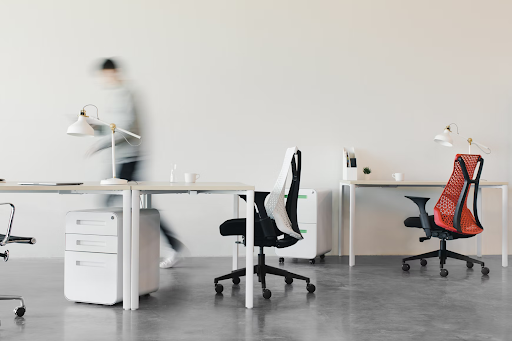You’ve got your desk and laptop or desktop computer. Now it’s time to find a high-quality and comfortable ergonomic chair.
Ergonomic chairs no longer belong solely to the realm of business usage. Many people have adapted them to home use for pleasure, including video gaming. However, a plethora of choices and higher costs can make shopping for this type of chair daunting. But, don’t worry—that’s where we come in. Keep reading to learn the five things you should consider before purchasing an ergonomic chair.
Seat Height, Width, and Depth
An ergonomic chair might be supportive and comfortable on its own, but it has to allow the user to sit comfortably at their desk or even conference table with their feet flat on the floor. Fortunately, most ergonomic chairs have adjustable heights, allowing users to keep their arms parallel to the ground when typing or using items in front of them. For most people, chairs with heights between 16 and 21 inches will work. But for someone who falls outside the average height range, petite or big-and-tall chairs may be necessary.
Like height, the width of the seat needs to accommodate the person sitting in it. A chair is only ergonomic when the user can sit in it comfortably. Businesses often purchase chairs with a standard width of 17 to 20 inches designed to fit most people. Unfortunately, this leaves some staff or clients without a comfortable place to sit because they don’t fit or have to squeeze in or perch on the edge awkwardly. Wide chairs may cost more, but most businesses will benefit from having at least a couple of wide chairs on site.
Along with height and width, depth finishes off the list of crucial elements to consider when buying an ergonomic chair. Generally, taller people require deeper seats to ensure their back meets the chair’s lumbar support. Their legs may extend far off the front of the chair if it’s too shallow. On the other hand, a shorter person won’t benefit from lumbar support if the seat is too deep. A well-fitting chair should leave between 2 and 4 inches of space between the edge of the chair and the back of the knees.
Adjustability
The most ergonomic chair adjusts to the user’s specific body shape, weight, and height. This makes sharing less than ideal. If more than one person plans to use the chair for more than a few moments, it’s essential to adjust the seat for the second user and back for the first.
Perhaps the most crucial aspect of adjustability in an ergonomic chair is its lumbar support. The support should contour to the curve of the user’s spine. Lumbar support that adjusts in height and depth is the best option for an ergonomic chair.
A seat with adjustable tilt helps the user’s back properly meet the backrest. Without this option, a chair will not be as comfortable as it could be or as ergonomic as it should be. And if the seat and backrest are separate, the back should also be adjustable to the front and back and lock in place.
Not all ergonomic chairs come with headrests, but adjustability is also essential for those who do. Anyone who has struggled with the height of a headrest in a vehicle knows how annoying it can be. A removable headrest might be the best option if it cannot be perfectly adjusted.
Finally, if the chair has armrests, they should be adjustable to accommodate the user’s height comfortably. However, some people may opt for ergonomic chairs without armrests to better fit beneath a desk or table.
Material
Buyers have plenty of options when it comes to ergonomic seating. Both leather and cloth upholstery are common. While the former wipes clean easily, the latter is more breathable. Mesh backs increase breathability in warmer climates and seasons but reduce lumber support. Regardless of fabric choice, the backrest and seat need adequate padding to be comfortable for the user who may sit for hours on end—up to 8 each day.
Swivel
Although it might seem unnecessary, a chair’s ability to swivel contributes to how ergonomic it is. Being able to easily turn to access work or other parts of a desk relieves strain on the muscles and spine. Casters can also extend the user’s range of motion, but some ergonomic chairs are stationary, such as those found in waiting rooms.
Once you’ve got the basics down, you can start browsing the best GT RACING gaming chairs to find one that fits your style and budget.
Although the advice above describes an ideal ergonomic chair, it might be higher than some buyers’ budgets. Luckily, working from home and the entrance of new manufacturers into the market means competitive prices. Plus, many makers offer warranties, and some chairs even come with money-back guarantees if the buyer is unsatisfied. All of this makes buying an ergonomic chair lower risk than ever, which means sitting at a desk can be as comfortable as ever.

